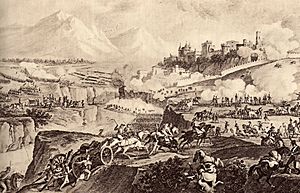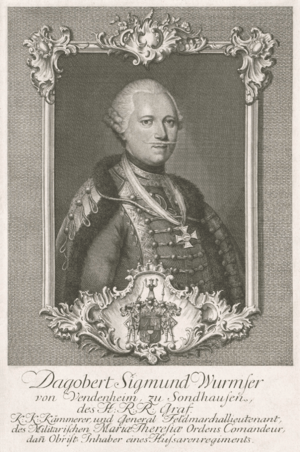Battle of Rovereto facts for kids
Quick facts for kids Battle of Rovereto |
|||||||
|---|---|---|---|---|---|---|---|
| Part of the Italian campaigns in the War of the First Coalition | |||||||
 Battle of Rovereto |
|||||||
|
|||||||
| Belligerents | |||||||
| Commanders and leaders | |||||||
| Strength | |||||||
| 20,000 | 20,000 | ||||||
| Casualties and losses | |||||||
| 750 | 6,000 killed or wounded, 4000 prisoners, 25 guns, 7 colours | ||||||
The Battle of Rovereto (also called Battle of Roveredo) happened on September 4, 1796. It was a big fight during the War of the First Coalition, which was part of the French Revolutionary Wars. In this battle, a French army led by Napoleon Bonaparte defeated an Austrian army group. The Austrian group was commanded by Paul Davidovich. The battle took place near the town of Rovereto in northern Italy, in a valley along the Adige River.
This battle was part of an effort to help the city of Mantua, which the French army was surrounding. The Austrians had left Davidovich's troops in the Adige valley. Meanwhile, two other Austrian divisions marched east and then south to Bassano del Grappa. The main Austrian commander, Dagobert von Würmser, planned to march from Bassano to Mantua. Davidovich's job was to pretend he would attack from the north, to keep the French busy.
But Napoleon Bonaparte had a different plan! He moved his army north with three divisions. This force was much bigger than Davidovich's troops. The French pushed the Austrians back all day long. By the afternoon, the Austrians were completely defeated. Davidovich had to retreat far to the north. This victory allowed Bonaparte to follow Würmser down the Brenta valley. Eventually, Würmser and his army got trapped inside Mantua.
Contents
Background to the Battle
Planning the Next Moves
After losing the Battle of Castiglione on August 5, the Austrian army, led by Feldmarschall Würmser, went north to Trento. At the same time, the French army continued to surround the city of Mantua. On August 24, French attacks pushed the Austrian soldiers defending Mantua back inside the fortress walls.
On August 26, Emperor Francis II of Austria ordered another attempt to help Mantua. Würmser's new chief-of-staff, Franz von Lauer, made a plan.
- The Austrian division near Bassano was made stronger with 10,700 soldiers.
- Würmser himself would lead two divisions from Trento into the Brenta River valley. This path went east, then south to Bassano.
- From Bassano, the Austrians would turn southwest, meet up with the other division, and march to Mantua.
The 17,300 Austrian soldiers inside Mantua were told to attack the French when the rescue army got close. Paul Davidovich and his 19,600 troops were supposed to defend Trento. If the French army facing him got weaker, he was to move south towards Mantua. Lauer thought the French army was tired and weak. He believed they would stay quiet while the Austrian rescue mission started.
But Napoleon Bonaparte had other ideas! The French government actually wanted his army to go north across the Brenner Pass. The goal was to meet up with another French army in Bavaria. So, Bonaparte planned to gather about 33,000 soldiers. These soldiers were from the divisions of Vaubois, André Masséna, and Pierre Augereau. Then, he planned to march them to Trento. His remaining 13,500 soldiers stayed behind to block Mantua and guard the Adige River near Verona.
The Battle of Rovereto
On September 1, the Austrian divisions began to move. Davidovich had about 19,555 troops, but only 13,695 were ready to fight right away. He placed some of his troops near Rovereto. Other troops were in Trento and west of the Adige River.
The French army also began to move.
- Vaubois, with 10,000 men, was west of Lake Garda. He sent some soldiers by boat and others marched north to Riva del Garda. Then, Vaubois turned east towards Rovereto.
- Masséna, with 13,000 troops, marched directly north up the Adige valley.
- Augereau, with 9,000 men, moved through the mountains north of Verona.
On September 3, Masséna's troops attacked about 1,500 of the Austrian soldiers near Ala. They pushed them back to Marco, a town on the east side of the Adige River. The Austrian commander, Vukassovich, tried to warn Davidovich. But Davidovich was away at a meeting in Trento. Meanwhile, Vaubois pushed back some Austrian troops near Nago-Torbole. He was ready to attack an Austrian position at Mori on the west side of the river. Würmser, the main Austrian commander, realized the French were threatening Trento. But he still decided to stick to his plan of moving through the Brenta valley.
At dawn on September 4, Masséna's division attacked the Austrians at Marco. One French group went straight up the main road. Another group took the high ground on the side. The Austrians fought hard, but they had to retreat so they wouldn't be surrounded. Masséna chased them quickly, breaking up many Austrian groups. When he reached Rovereto, Vukassovich tried to hold his ground again until noon. Then, he fell back towards Calliano with the rest of his soldiers. By this time, Vaubois had captured Mori on the west bank of the river.
Davidovich placed some of his soldiers in a strong position in the Adige gorge. This was to cover his retreating troops. However, these soldiers were tired and had already lost many men. They had been forced out of several defensive spots. The French, helped by their cannons, attacked in large groups and broke through. The Austrian commanders, Vukassovich and Sporck, thought they were safe. When they reached Calliano, they let their soldiers start cooking dinner. But without warning, the French stormed into their camp late in the afternoon. This caused the remaining Austrians to run away in a complete defeat.
Results of the Battle
The French army lost about 750 soldiers during the day. The Austrians suffered much heavier losses. They had between 3,000 and 10,000 soldiers killed, wounded, or captured. The French also captured 25 cannons and 7 flags. During the night, Davidovich left Trento and retreated north to Lavis. This village was at the edge of Austrian territory. He met up with more Austrian troops there.
Masséna entered Trento on the morning of September 5, with Vaubois following him. It was then that Napoleon Bonaparte found out Würmser's plan to march east into the Brenta valley. Bonaparte decided to change his own plan completely.
Instead of going back down the Adige River with his whole army, Bonaparte made a very bold move. He ordered Vaubois to block the passes north of Trento with 10,000 men. Then, the other 22,000 French soldiers set off to chase Würmser down the same path the Austrians were using! This was very risky. The French army would have to find all their food and supplies along the way. If they were stopped even for a short time in the Alps, they could starve.
On September 5, Vaubois crossed the bridge over the Avisio river. He attacked Davidovich at Lavis and pushed him even farther north. Once Bonaparte was sure Davidovich was no longer a threat, he sent Augereau's division to Levico Terme. They were following Würmser's army. Soon, Masséna's troops followed Augereau. This led to a smaller fight at Primolano on September 7, and then the big Battle of Bassano on September 8.
See also




